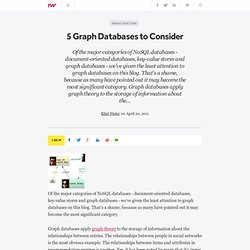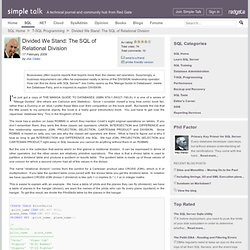

DataStax Cassandra 1.1 Documentation. Planning a data model in Cassandra involves different design considerations than you may be used to if you work with relational databases.

Ultimately, the data model you design depends on the data you want to capture and how you plan to access it. However, there are some common design considerations for Cassandra data model planning. Start with Queries The best way to approach data modeling for Cassandra is to start with your queries and work back from there. Think about the actions your application needs to perform, how you want to access the data, and then design column families to support those access patterns. For example, start with listing the use cases your application needs to support. Memcached - a distributed memory object caching system. Exploration of NoSQL: FlockDB.
In our last article, we touched on the Facebook born NoSQL database called Casandra.

For this article, we’ll jump over to the other major player in social media: Twitter. Twitter recently celebrated its 5th birthday, and posted some stats boasting one billion tweets per week. This, coupled with an average of 420,000 new Twitter accounts per day, makes for some interesting database scenarios. How can you handle this massive amount of tweeting, account creation, and connection between accounts (following, un-following, blocking, etc)? FlockDB was born to handle these problems. Graph Databases, NOSQL and Neo4j. Introduction Of the many different datamodels, the relational model has been dominating since the 80s, with implementations like Oracle, MySQL and MSSQL - also known as Relational Database Management System (RDBMS).

Lately, however, in an increasing number of cases the use of relational databases leads to problems both because of Deficits and problems in the modeling of data and constraints of horizontal scalability over several servers and big amounts of data. There are two trends that bringing these problems to the attention of the international software community: The exponential growth of the volume of data generated by users, systems and sensors, further accelerated by the concentration of large part of this volume on big distributed systems like Amazon, Google and other cloud services. The increasing interdependency and complexity of data, accelerated by the Internet, Web2.0, social networks and open and standardized access to data sources from a large number of different systems.
NoSQL GraphDB. I received some constructive criticism regarding my previous blog in NoSQL patterns that I covered only the key/value store but have left out Graph DB.

The Property Graph Model A property graph is a collection of Nodes and Directed Arcs. Each node represents an entity and has an unique id as well as a Node Type. The Node Type defines a set of metadata that the node has. Each arc represents a unidirectional relationship between two entities and has an Arc Type. General Graph Processing I found many of the graph algorithms follows a general processing pattern. This model is similar to the Google Pregel model. Notice that this model maps well into parallel computing environment where the processing of the set of active node can be spread across multiple processors (or multiple machines in a cluster) Notice that all messages from all in-coming links are arrived before the link changes within local processing.
Neo4j provide a restricted, single-threaded graph traversal model . 5 Graph Databases to Consider. Of the major categories of NoSQL databases - document-oriented databases, key-value stores and graph databases - we've given the least attention to graph databases on this blog.

That's a shame, because as many have pointed out it may become the most significant category. Graph databases apply graph theory to the storage of information about the relationships between entries. The relationships between people in social networks is the most obvious example. The relationships between items and attributes in recommendation engines is another. Yes, it has been noted by many that it's ironic that relational databases aren't good for storing relationship data.
Divided We Stand: The SQL of Relational Division. Businesses often require reports that require more than the classic set operators.

Surprisingly, a business requirement can often be expressed neatly in terms of the DIVISION relationship operator: How can this be done with SQL Server? Joe Celko opens up the 'Manga Guide to Databases', meets the Database Fairy, and is inspired to explain DIVISION. I’ve just got a copy of THE MANGA GUIDE TO DATABASES (ISBN 978-1-59327-190-9); it is one of a series of “Manga Guides” (the others are Calculus and Statistics).
Since I consider myself a long time comic book fan, rather than a Dummy or an Idiot, I prefer these titles over their competition on the book shelf. All your database are belong to you. Common MySQL Queries. Common MySQL Queries Basic aggregation Last updated 01 Oct 2016 Aggregate across columns Last updated 09 Sep 2009 Aggregates across multiple joins Given a parent table and two child tables, a query which sums values in both child tables, grouping on a parent table column, returns sums that are exactly twice as large as they should be. CREATE TABLE packageCredit ( packageCreditID INT, packageCreditItemID INT, Last updated 22 Feb 2013.
Java & .NET Object Database – Open Source Object Database, Open Source Persistence, Oodb. What the heck are you actually using NoSQL for? Bossie Awards 2012: The best open source databases.